- Details
- Hits: 1042
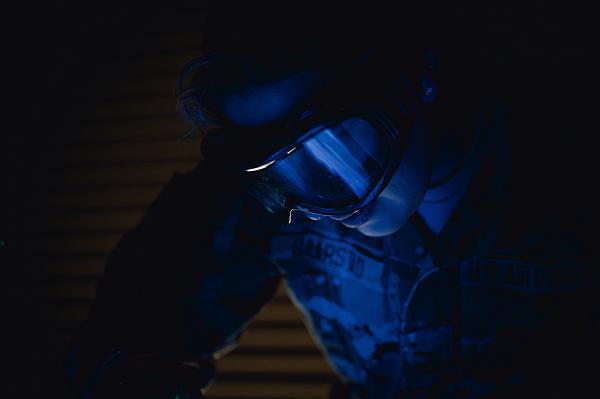
Tyndall Air Force Base, Florida. (June 15, 2024): In the fast-paced world of military aviation, aircraft parts suffer wear and tear that, if undetected, could cause a catastrophe. Aboard ships, there is little time to analyze aircraft parts for damage, especially for ‘destructive’ testing that requires dissolving materials into liquids. In this photo by Airman 1st Class Zeeshan Naeem, Airman 1st Class Gwynavere Baarstad, 325th Maintenance Squadron non-destructive inspection apprentice, checks a simulated aircraft part for damage. Traditional chemistry requires using acid to liquify a sample for analysis by Atomic Absorption or X-Ray Fluorescence (tools to measure the elemental content) that require the sample to be destroyed. Nondestructive testing (NDT), by contrast, is a multidisciplinary profession that blends quality assurance and materials science to inspect and evaluate materials without destroying their serviceability.
For the Air Force, this means using analytical methods like ultrasound, X-rays, and fluorescent dies to ensure aircraft components are operational and ready for the next mission. The goal of non-destructive inspection is to identify even the tiniest defect in systems or equipment that could become a danger to an aircraft. These highly skilled technicians use three primary methods to peer inside vital components, Ultrasonic Testing, Eddy Current Testing, and Radiographic Testing.
Expectant parents are familiar with the most used non-destructive tool to check aircraft parts for possible defects, the Ultrasound. Ultrasonic testing uses high-frequency sound waves to inspect for flaws in the thickness of a material without altering it chemically. When sound waves hit a defect, they bounce back to give a real time view of the interior of a sample.
Eddy Current Testing uses a conductive wire to create an electromagnetic current that is used to probe the surfaces of materials. These currents are extremely sensitive and can find even the minutest defect or flaw on the surface of a conductive material. Eddy currents are ideal for testing materials under extreme conditions such as underwater or on hot temperature surfaces.
- Details
- Hits: 872
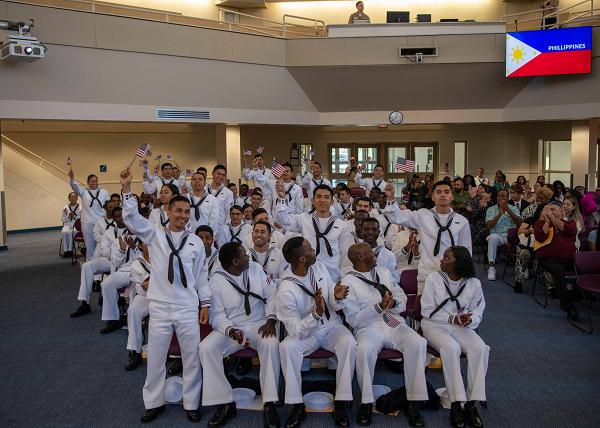
Naval Station Great Lakes, Illinois. (June 12, 2024): In this photo by MC2 Stuart Posada, Navy recruits take the Naturalization Oath of Allegiance during a ceremony held at Recruit Memorial Chapel. These “New Americans” join hundreds of thousands of immigrants that have served in our armed forces since the beginning of our republic. In the last twenty years, more than 148,000 immigrants earned their U.S. citizenship by serving and in the past century, over 760,000 immigrants from thirty countries became Americans through military service. In fact, twenty percent of all Medal of Honor winners were foreign born.
These aspiring citizens not only bring exceptional skills, like language. but are also less likely than their U.S. born counterparts to leave the military. Today, there are approximately 65,000 immigrants, five percent of the force, serving on active duty and non-citizens account for four percent of all recruits annually.
To become a naturalized citizen, recruits must complete at least one year of honorable service during peacetime, or they may be granted citizenship immediately if their service occurred during designated periods of hostility. Last year, some twelve thousand service members gained their citizenship, a fourteen percent increase on the previous year.
Since the beginning of the republic, the American armed forces have offered a path to citizenship for patriots willing to fight to defend our country.
- Details
- Hits: 979
.jpg)
Câmpia Turzii, Romania. (June 10, 2024): If the Russians follow through on threats to invade Europe, will America be ready to move air and equipment assets across the seas in time? That is the question that Exercise Astral Knight 24 is attempting to answer. In this photo by Airman 1st Class Albert Morel, a flight of F-16s joust in the skies above Romania as part of a NATO air and missile defense exercise.
Exercise Astral Knight has gained urgency with Russia’s invasion of Ukraine and warnings by Vladimir Putin that he will use missiles and even nuclear weapons against the West. NATO has stepped up the pace of realistic exercises to counter these arial threats.
Some fifty U.S. aircraft participated in simulated combat operations in the skies over Poland and the Baltic States of Estonia, Latvia, Lithuania. The British Air Force also participated and personnel from Denmark and Greece were sent as observers.
This year’s Astral Knight focused on how to counter attacks from relatively cheap Iranian-made drones like the ones launched against Ukraine’s air defenses. According to the U.S. Air Force Europe (USAFE), at least one hundred and seventy drone, rocket, and missile attacks have been launched against U.S. troops in Iraq, Syria, and Jordan since October. The goal is to create an effective, multi-layered missile defense system like those employed by Israel. When Iran recently launched hundreds of ballistic missiles and drones, Israel, U.S., and coalition partners shot them down before they could cause any damage. NATO hopes to establish a protective umbrella like this for Europe as well.
Read more: European Invasion… Will U.S. Help Arrive On Time?
- Details
- Hits: 993
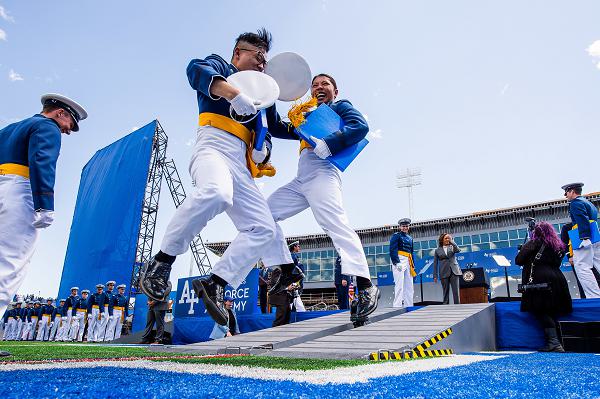
Colorado Springs, Colorado. (June 11, 2024): In this photo by Trevor Cokley, Air Force Academy Cadets dance a jig upon receiving their diploma this week. Held at Falcon Stadium, nine hundred and seventy-four Cadets crossed the stage to become Air Force second lieutenants.
Although a separate and distinct branch, the Class of 2024 included ninety-three Space Force officers who trained alongside their Air Force counterparts. This year’s class also included fifteen international students from allied nations around the world. Roughly thirty seven percent were selected to attend undergraduate pilot training.
- Details
- Hits: 1110
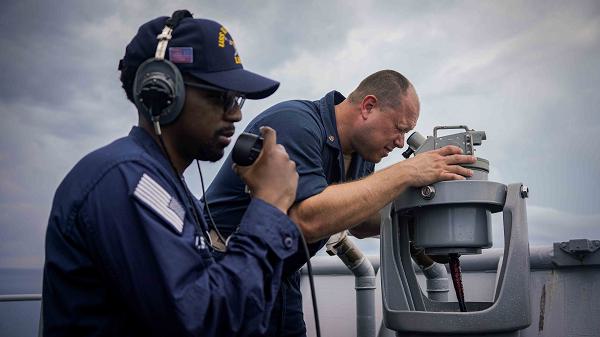
Puerto Princesa, Philippines. (June 6, 2024): Despite all the high-tech developments of late, determining the bearing and relaying the distance of enemy targets is still done in a very traditional way, In this photo by MC2 Sang, Kim, Chief Quartermaster Matthew Frey, right, looks through a telescopic Alidade as Quartermaster 3rd Class James Handy, left, operates a Sound Powered Telephone during a sea and anchor evolution aboard the amphibious dock landing ship USS Harpers Ferry.
A telescopic Alidade is an instrument used for determining direction or “bearing” of a distant object. In navigation, a bearing is the relationship between an object and magnetic north on a compass. For example, an object that is due East from your position would be reported at an angle (or azimuth) of ninety degrees. The operator peers through a telescope to “sight” the object while reading its location in degrees at the same time.
In the early days, Alidades were used in fire towers for sighting the bearing to a forest fire. The observer looks through two sights while adjusting them until they are aligned with the smoke from the fire. These sighting devices have likewise served aboard U.S. Navy vessels for decades.
The Alidade readings are relayed to key personnel onboard via a Sound Powered Telephone, a technology that came into service during World War II. These communication devices allow users to speak to each other with a handset that is like a conventional telephone but doesn’t require the use of external power. First employed on Navy ships in 1944, the phones form a circuit to allow communication between key locations on a vessel if power is unavailable.
- Details
- Hits: 1127
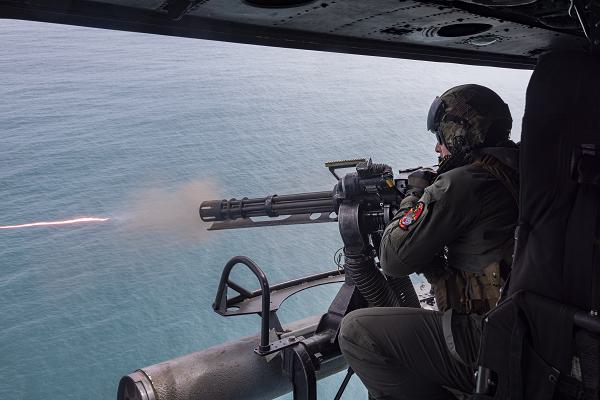
Skies Above North Carolina. (June 5, 2024): In 1861, a gunsmith named Richard Gatling had an idea, one that revolutionized warfare to this day. He invented the rotary cannon, a multiple barrel machine gun with a huge rate of fire that terrorized the enemy. In this photo by Lance Corporal Orlanys Diaz Figueroa, Gunnery Sergeant Parrish Hall II, a UH-1Y Venom crew chief with Marine Light Attack Helicopter Squadron 167, fires a GAU-17A minigun during live fire maritime to surface warfare training.
What began as a hand operated “Gatling Gun” has evolved into today’s multiple versions and capabilities, all of which are deadly. First used in combat by U.S. forces during the Civil War, the six-barrel gun went on to see service in the Japanese Civil War, the Anglo-Zulu Wars, and it even played a part in Teddy’s Roosevelt’s charge up San Juan Hill during the Spanish-American War.
These early versions used multiple barrels (up to ten) to limit overheating, a rotating mechanism, and a gravity fed reloading system that could fire up to two hundred rounds a minute. Despite its promise, the Gatling Gun fell out of favor with militaries of the time and Gatling himself ended up declaring bankruptcy.
Until World War II.


